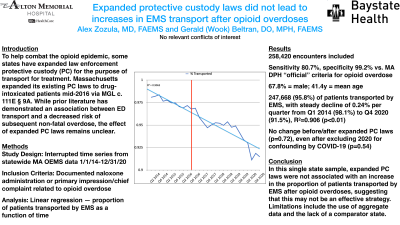Back


(1) Expanded Protective Custody Laws Did Not Increase EMS Transport After Opioid Overdoses
Friday, April 1, 2022
11:30 AM – 1:00 PM ET
Location: Great Hall Foyer, Third Floor

Has Audio

Alexander Zozula, MD, FAEMS
EMS Medical Director
Alton Memorial Hospital, Illinois- GB
Gerald (Wook) Beltran, DO, MPH
Regional EMS Medical Director
Baystate Health, Massachusetts
Presenter(s)
Non-presenting author(s)
Abstract Body
Introduction
In an effort to combat the opioid epidemic, some states have expanded law enforcement powers to place patients into protective custody (PC) for the purpose of transport to a treatment facility. Massachusetts (MA) expanded its existing PC regulations to drug-intoxicated patients mid-2016 with the passing of MGL Chapter 111E Section 9A. While prior literature has demonstrated an association between transport to an emergency department and a decreased risk of subsequent non-fatal opioid overdose, the specific effect of expanded PC laws remains unclear.
Methods
All EMS encounters in MA between January 1, 2014 and December 31, 2020 were included if either naloxone administration was documented or the provider documented a primary impression and/or chief complaint related to opioid overdose. Aggregate data were provided by the MA Office of Emergency Medical Services (OEMS, which falls under the Department of Public Health) grouped by calendar quarter (e.g. January-March 2014) and included gender, age, and whether EMS transported the patient. Linear regression was used to analyze the proportion of patients transported by EMS as a function of time. Sensitivity analysis was also performed excluding 2020 for possible confounding by changes in transport patterns related to COVID-19.
Results
258,420 encounters met the inclusion criteria for the study. Of these, 175,105 (67.8%) patients were male with a mean age of 41.4 years. Overall, 247,668 (95.8%) of patients were transported by EMS, with a steady decline of approximately 0.24% per quarter from Q1 2014 (98.1%) to Q4 2020 (91.5%), R2=0.906 (p < 0.01). There was no significant change before and after the implementation of expanded PC laws (p=0.72). The lack of effect of expanded PC laws persisted even after excluding 2020 for potential confounding by COVID-19 (p=0.54).
Conclusion
In this single state sample, expanded protective custody regulations were not associated with an increase in the proportion of patients transported by EMS after opioid overdoses, suggesting that this may not be an effective strategy for combating the opioid epidemic. Limitations include the use of aggregate data and the lack of a comparator state without expanded PC regulations. Future research should evaluate expanded PC regulations in jurisdictions with lower baseline transport rates.
References
1. https://malegislature.gov/Laws/GeneralLaws/PartI/TitleXVI/Chapter111E/Section9A
2. Zozula A, Neth MR, Hogan AN, Stolz U, McMullan J. Non-transport after Prehospital Naloxone Administration Is Associated with Higher Risk of Subsequent Non-fatal Overdose. Prehosp Emerg Care. 2021 Feb 26:1-11. Epub ahead of print. PMID: 33535012.
3. Glenn MJ, Rice AD, Primeau K, Hollen A, Jado I, Hannan P, McDonough S, Arcaris B, Spaite DW, Gaither JB. Refusals After Prehospital Administration of Naloxone during the COVID-19 Pandemic. Prehosp Emerg Care. 2021 Jan-Feb;25(1):46-54. Epub 2020 Nov 3. PMID: 33054530.
Diversity, Equity, and Inclusion: Unfortunately specific race/ethnicity data is not well captured by the MA OEMS as these are optional fields in most EMS charting software. However, this study analyzed data from the entire state of MA and is likely representative of the population that interacts with EMS after opioid overdose events. One of the aims of this study was to see if there is justification to further involve law enforcement in the care of these patients, many of whom are already reluctant to seek help because of fear of legal repercussions.
Introduction
In an effort to combat the opioid epidemic, some states have expanded law enforcement powers to place patients into protective custody (PC) for the purpose of transport to a treatment facility. Massachusetts (MA) expanded its existing PC regulations to drug-intoxicated patients mid-2016 with the passing of MGL Chapter 111E Section 9A. While prior literature has demonstrated an association between transport to an emergency department and a decreased risk of subsequent non-fatal opioid overdose, the specific effect of expanded PC laws remains unclear.
Methods
All EMS encounters in MA between January 1, 2014 and December 31, 2020 were included if either naloxone administration was documented or the provider documented a primary impression and/or chief complaint related to opioid overdose. Aggregate data were provided by the MA Office of Emergency Medical Services (OEMS, which falls under the Department of Public Health) grouped by calendar quarter (e.g. January-March 2014) and included gender, age, and whether EMS transported the patient. Linear regression was used to analyze the proportion of patients transported by EMS as a function of time. Sensitivity analysis was also performed excluding 2020 for possible confounding by changes in transport patterns related to COVID-19.
Results
258,420 encounters met the inclusion criteria for the study. Of these, 175,105 (67.8%) patients were male with a mean age of 41.4 years. Overall, 247,668 (95.8%) of patients were transported by EMS, with a steady decline of approximately 0.24% per quarter from Q1 2014 (98.1%) to Q4 2020 (91.5%), R2=0.906 (p < 0.01). There was no significant change before and after the implementation of expanded PC laws (p=0.72). The lack of effect of expanded PC laws persisted even after excluding 2020 for potential confounding by COVID-19 (p=0.54).
Conclusion
In this single state sample, expanded protective custody regulations were not associated with an increase in the proportion of patients transported by EMS after opioid overdoses, suggesting that this may not be an effective strategy for combating the opioid epidemic. Limitations include the use of aggregate data and the lack of a comparator state without expanded PC regulations. Future research should evaluate expanded PC regulations in jurisdictions with lower baseline transport rates.
References
1. https://malegislature.gov/Laws/GeneralLaws/PartI/TitleXVI/Chapter111E/Section9A
2. Zozula A, Neth MR, Hogan AN, Stolz U, McMullan J. Non-transport after Prehospital Naloxone Administration Is Associated with Higher Risk of Subsequent Non-fatal Overdose. Prehosp Emerg Care. 2021 Feb 26:1-11. Epub ahead of print. PMID: 33535012.
3. Glenn MJ, Rice AD, Primeau K, Hollen A, Jado I, Hannan P, McDonough S, Arcaris B, Spaite DW, Gaither JB. Refusals After Prehospital Administration of Naloxone during the COVID-19 Pandemic. Prehosp Emerg Care. 2021 Jan-Feb;25(1):46-54. Epub 2020 Nov 3. PMID: 33054530.
Diversity, Equity, and Inclusion: Unfortunately specific race/ethnicity data is not well captured by the MA OEMS as these are optional fields in most EMS charting software. However, this study analyzed data from the entire state of MA and is likely representative of the population that interacts with EMS after opioid overdose events. One of the aims of this study was to see if there is justification to further involve law enforcement in the care of these patients, many of whom are already reluctant to seek help because of fear of legal repercussions.
